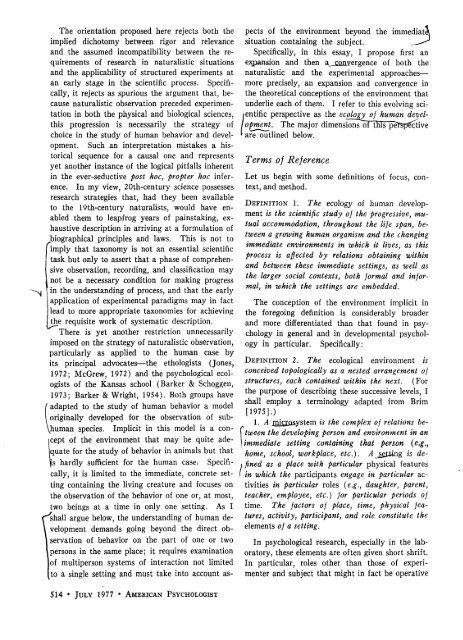Bronfenbrenner 1977
You also want an ePaper? Increase the reach of your titles
YUMPU automatically turns print PDFs into web optimized ePapers that Google loves.
The orientation proposed here rejects both the<br />
implied dichotomy between rigor and relevance<br />
and the assumed incompatibility between the requirements<br />
of research in naturalistic situations<br />
and the applicability of structured experiments at<br />
an early stage in the scientific process. Specifically,<br />
it rejects as spurious the argument that, because<br />
naturalistic observation preceded experimentation<br />
in both the physical and biological sciences,<br />
this progression is necessarily the strategy of<br />
choice in the study of human behavior and development.<br />
Such an interpretation mistakes a historical<br />
sequence for a causal one and represents<br />
yet another instance of the logical pitfalls inherent<br />
in the ever-seductive post hoc, propter hoc inference.<br />
In my view, 20th-century science possesses<br />
research strategies that, had they been available<br />
to the 19th-century naturalists, would have enabled<br />
them to leapfrog years of painstaking, exhaustive<br />
description in arriving at a formulation of<br />
biographical principles and laws. This is not to<br />
imply that taxonomy is not an essential scientific<br />
task but only to assert that a phase of comprehensive<br />
observation, recording, and classification may<br />
not be a necessary condition for making progress<br />
in the understanding of process, and that the early<br />
application of experimental paradigms may in fact<br />
lead to more appropriate taxonomies for achieving<br />
the requisite work of systematic description.<br />
There is yet another restriction unnecessarily<br />
imposed on the strategy of naturalistic observation,<br />
particularly as applied to the human case by<br />
its principal advocates—the ethologists (Jones,<br />
1972; McGrew, 1972) and the psychological ecologists<br />
of the Kansas school (Barker & Schoggen,<br />
1973; Barker & Wright, 1954). Both groups have<br />
/ adapted to the study of human behavior a model<br />
1 originally developed for the observation of sub-<br />
514 • JULY <strong>1977</strong> • AMERICAN PSYCHOLOGIST<br />
\human species. Implicit in this model is a conicept<br />
of the environment that may be quite adequate<br />
for the study of behavior in animals but that<br />
fs hardly sufficient for the human case. Specifically,<br />
it is limited to the immediate, concrete setting<br />
containing the living creature and focuses on<br />
the observation of the behavior of one or, at most,<br />
two beings at a time in only one setting. As I<br />
shall argue below, the understanding of human development<br />
demands going beyond the direct observation<br />
of behavior on the part of one or two<br />
persons in the same place; it requires examination<br />
of multiperson systems of interaction not limited<br />
to a single setting and must take into account aspects<br />
of the environment beyond the immediate<br />
situation containing the subject. .._-^<br />
Specifically, in this essay, I propose first an<br />
expansion and then a_jcp_n_yergence Of both the<br />
naturalistic and the experimental approaches—<br />
more precisely, an expansion and convergence in<br />
the theoretical conceptions of the environment that<br />
underlie each of them. I refer to this evolving sci-<br />
/entific perspective as the ecology o] human development.<br />
The major dimension-Tof this perspective<br />
''are outlined below.<br />
Terms oj Reference<br />
Let us begin with some definitions of focus, context,<br />
and method.<br />
DEFINITION 1. The ecology of human development<br />
is the scientific study of the progressive, mutual<br />
accommodation, throughout the life span, between<br />
a growing human organism and the changing<br />
immediate environments in which it lives, as this<br />
process is affected by relations obtaining within<br />
and between these immediate settings, as well as<br />
the larger social contexts, both formal and informal,<br />
in which the settings are embedded.<br />
The conception of the environment implicit in<br />
the foregoing definition is considerably broader<br />
and more differentiated than that found in psychology<br />
in general and in developmental psychology<br />
in particular. Specifically:<br />
DEFINITION 2. The ecological environment is<br />
conceived topologically as a nested arrangement of<br />
structures, each contained within the next. (For<br />
the purpose of describing these successive levels, I<br />
shall employ a terminology adapted from Brim<br />
[1975].)<br />
1. A microsystem is the complex of relations be-<br />
[ tween the developing person and environment in an<br />
I immediate setting containing that person (e.g.,<br />
home, school, workplace, etc.). A > .S£liing is dei<br />
fined as a place with particular physical features<br />
f in which the participants engage in particular activities<br />
in particular roles (e.g., daughter, parent,<br />
teacher, employee, etc.) for particular periods of<br />
time. The factors of place, time, physical features,<br />
activity, participant, and role constitute the<br />
elements of a setting.<br />
In psychological research, especially in the laboratory,<br />
these elements are often given short shrift.<br />
In particular, roles other than those of experimenter<br />
and subject that might in fact be operative


